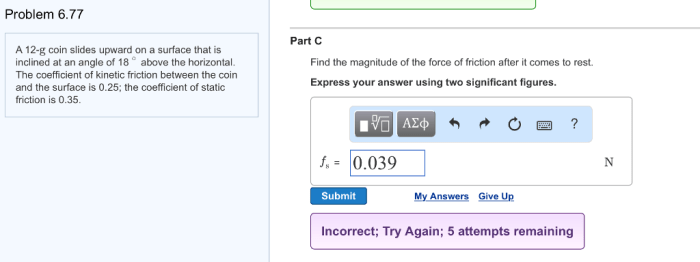A coin slides over a frictionless plane, embarking on a journey that unveils the fundamental principles of motion, forces, energy, and their interplay. This exploration delves into the intricate dance of a coin’s trajectory, revealing the underlying physics that govern its path.
As the coin embarks on its frictionless journey, it encounters a unique set of conditions that shape its motion. The absence of friction allows it to glide effortlessly, unhindered by resistive forces. The plane’s orientation introduces a gravitational influence, dictating the coin’s trajectory and acceleration.
Motion of a Coin on a Frictionless Plane: A Coin Slides Over A Frictionless Plane

The motion of a coin sliding on a frictionless plane is a classic example of projectile motion. In this scenario, we assume that the plane is perfectly smooth and level, eliminating any frictional forces that would impede the coin’s movement.
Initial Conditions, A coin slides over a frictionless plane
Initially, the coin is placed at a certain position on the plane with a specific velocity. The orientation of the plane is typically horizontal or inclined at a known angle.
Motion of the Coin
Once released, the coin undergoes projectile motion. It follows a parabolic trajectory due to the combined effects of its initial velocity and the constant acceleration due to gravity. The coin’s speed remains constant in the horizontal direction, while its vertical speed changes as it rises and falls under the influence of gravity.
Forces Acting on the Coin
The primary force acting on the coin is gravity, which pulls it downwards. The absence of friction ensures that there are no horizontal forces acting on the coin, allowing it to move freely along the plane.
Energy Considerations
As the coin moves, its kinetic energy (energy of motion) is constantly being converted into potential energy (energy due to position) and vice versa. At the highest point of its trajectory, the coin’s kinetic energy is zero, and its potential energy is at a maximum.
Conversely, at the lowest point of its trajectory, the coin’s kinetic energy is at a maximum, and its potential energy is zero.
Real-World Applications
The motion of a coin sliding on a frictionless plane has practical applications in various fields. For example, it is used to study projectile motion in physics classes, design roller coasters and other amusement park rides, and analyze the trajectory of objects in sports like baseball and golf.
User Queries
What is the significance of friction in this scenario?
Friction, if present, would oppose the coin’s motion, decelerating it and eventually bringing it to rest. In the absence of friction, the coin can continue sliding indefinitely.
How does the orientation of the plane affect the coin’s motion?
The orientation of the plane determines the direction of the gravitational force acting on the coin. This force influences the coin’s trajectory and acceleration.
What energy transformations occur during the coin’s motion?
As the coin slides, its kinetic energy (energy of motion) is converted into potential energy (energy due to position) as it moves up the plane. Conversely, as it slides down, its potential energy is converted back into kinetic energy.


